Last updated on January 19th, 2024 at 06:46 am
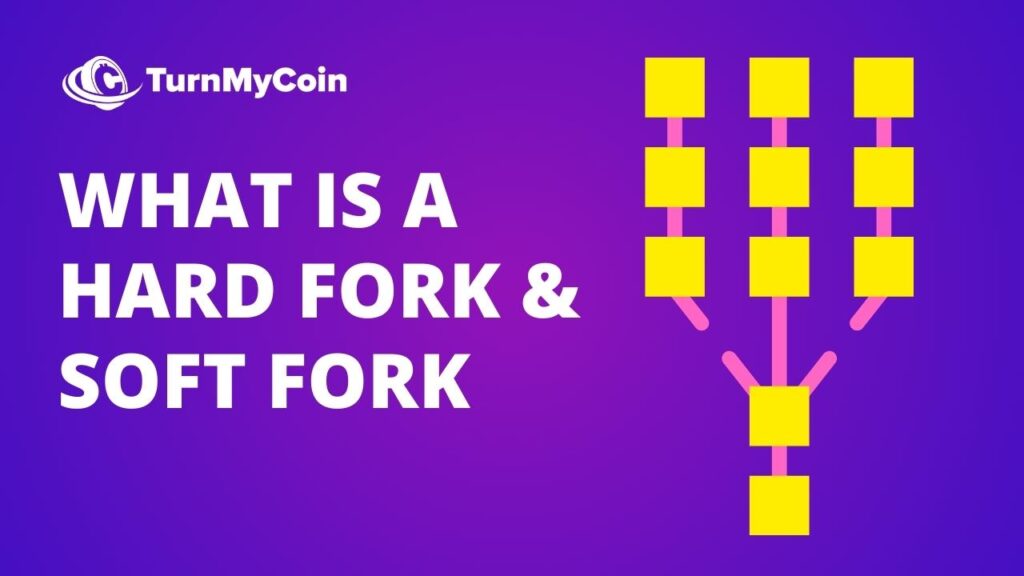
Blockchains are decentralized, open-source technologies that fuel cryptocurrencies like Bitcoin and Ethereum. A fork is a protocol upgrade to the blockchain system. A blockchain split is a significant upgrade to the network that can be initiated by either developers or community members and can be dramatic or incremental.
To validate transactions on the blockchain, node operators must update their equipment to the most recent version of the protocol. Each node stores its copy of the blockchain and verifies that new transactions do not invalidate previous ones.
A hard fork is a significant upgrade that can render previously valid transactions and blocks invalid, necessitating an upgrade by all validators in the network. It cannot be used with older devices. A soft fork is an upgrade to the software compatible with prior versions of the chain and is accepted as valid by validators in those systems.
Because the old version is incompatible with the new one, a hard fork effectively causes a permanent chain separation. Because the old and new chains have the exact provenance, token holders on the old chain are automatically allocated tokens on the new chain. For a variety of reasons, hard forks can happen.
Table of Contents
Understanding hard forks
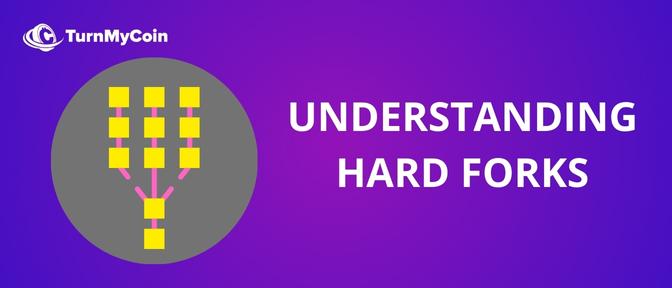
Understanding blockchain technology is a prerequisite to grasping the concept of a hard fork. Simply put, a blockchain is a digital ledger consisting of linked blocks of data, each of which cannot be considered genuine until the network’s validators have verified it. Everything recorded in the blockchain is fully auditable, down to the very first transaction ever made. This is why the very first block of Bitcoin’s blockchain is still accessible.
When some nodes in a blockchain fail to reach a consensus on the most recent block, the blockchain splits in two and continues to operate as two independent networks; this is known as a hard fork.
This creates a split in the blockchain, with one branch continuing to use the old rules and the other adopting the new ones. With a hard fork, the previous version will no longer recognize the updated one as legitimate.
Common fears
Many people fear hard forks because of the potential for a chain to break off at the split. The network’s security is compromised, and its vulnerability to assaults is increased if there is a breach of trust between the miners who protect it and the nodes that help validate transactions.
When a group of miners gets control of more than 51% of the processing power used to secure a network, they can launch a 51% attack and rewrite the blockchain’s history for nefarious purposes. The same funds have been double-spent by malicious actors in several 51% attacks on some networks developed due to hard forks. In these types of attacks, bad actors use their disproportionate share of the network’s computer capacity to restructure blocks to facilitate double spending.
Hard forks can also be susceptible to replay assaults as a transaction is being processed on a split network; a malicious actor can intercept and replay it on the other chain, resulting in a replay attack. Both transactions become legal after a hard fork without security against replay attacks, allowing an unauthorized third party to steal the cash of an unsuspecting user.
When do hard forks occur, and why?
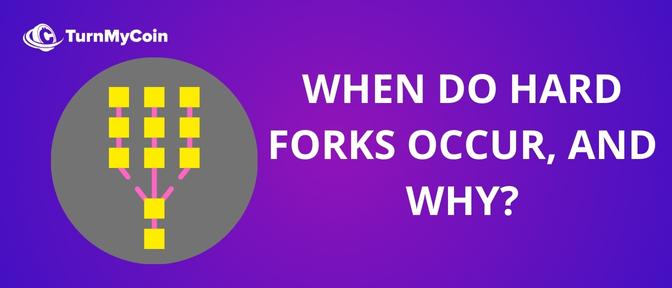
Why do hard forks ever happen if they can substantially lower a blockchain’s security? It’s a quick and easy fix: As blockchain technology advances, hard forks—upgrades that improve the network—are inevitable. A hard fork may have several causes, not all of which are bad:
Why do hard forks happen?
- Fix potential security flaws.
- Find a consensus among cryptocurrency users who are at odds.
- Blockchain transactions that roll back
- Accidents can also cause hard forks to happen. Most of the time, these problems are quickly fixed, and the nodes that had lost sync with the main blockchain eventually re-establish consensus. Similarly, people deviating from consensus can re-join the main chain after a hard fork that adds features and upgrades the network.
Unintentional hard forks
There have been numerous unintentional hard forks on the Bitcoin network. They occur more frequently than you might believe and are usually fixed so fast that they are barely noticeable.
A hard fork is almost inevitable when two miners discover the same block nearly simultaneously. Both initially accept the block as genuine and continue mining on separate chains until either they or another miner adds a following block, reflecting the decentralized nature of network consensus.
Depending on which chain has the next longer block, the other one must be dropped in order to keep the network in agreement. As mining Bitcoin on the abandoned chain would now result in mining a network fork, miners move on to the longest chain.
When this happens, the miner who discovered the abandoned block loses their initial currency reward and any transaction fees they would have earned. As the two blocks discovered were similar and included the same transactions, no transactions would be revoked.
Several hard forks occurred unintentionally due to coding bugs that caused short-chain splits. For instance, in 2013, a block was mined and broadcast with more total transaction inputs than had been observed before; nonetheless, some nodes did not process it, causing a split. After some nodes rolled back their software updates to establish consensus and reject this larger block, the problem was fixed.
Hard forks and soft forks have distinct differences.
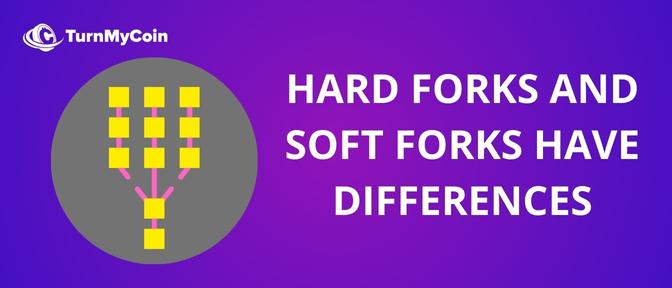
Besides hard forks, there are other ways to update the cryptocurrency’s underlying software. But, nodes that do not upgrade to the newer versions will still see the chain as valid in the case of a soft fork, making it a safer alternative.
The rules that a blockchain must adhere to can remain unchanged while new features and functions are added via a soft fork. New features in software are frequently introduced via soft forks.
Hard and soft forks can be conceptualized as the equivalent of a simple upgrade to a mobile device’s or computer’s operating system, respectively. After the upgrade, the device’s current apps will continue functioning normally with the new OS. In this case, a hard fork would be the equivalent of switching to an entirely other operating system.
Many Famous Hard Fork Examples
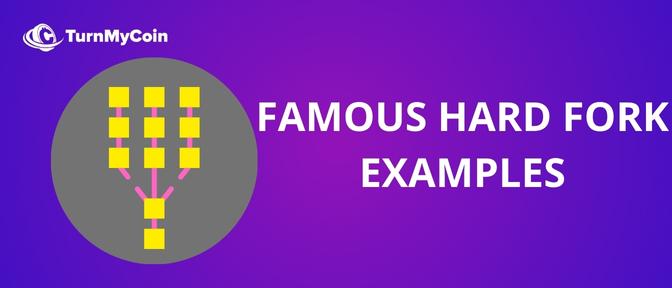
Many hard forks have occurred in the history of cryptocurrencies, not all involving the Bitcoin network. Some of the most influential hard forks in the industry’s history are listed below.
Bitcoin Cash and SegWit2x
An upgrade called SegWit2x was proposed so that Bitcoin could handle more users. The block size limit of the cryptocurrency network was supposed to double from 1 MB to 2 MB, and the Segregated Witness (SegWit) protocol was supposed to be implemented.
On May 23, 2017, a controversial agreement was made in New York that would see the adoption of SegWit2x. A group of Bitcoin entrepreneurs and miners controlling more than 85% of the network’s hash rate agreed on the cryptocurrency’s future.
A soft fork would be used to install SegWit, while a hard fork would apply the block size restriction. The idea was divisive since it did not involve any developer from Bitcoin Core, the network’s primary codebase, and because it was perceived as a centralized force, with a small group of firms choosing the fate of the network rather than the miners and nodes. Consensus was reached after years of discussion over how to increase Bitcoin’s capacity.
Proponents of smaller blocks contended that the increased difficulty of hosting a full node posed a threat of centralization. Larger block advocates said that Bitcoin’s (BTC) growing transaction costs would stunt the cryptocurrency’s development and drive some users away.
Softforks initiation
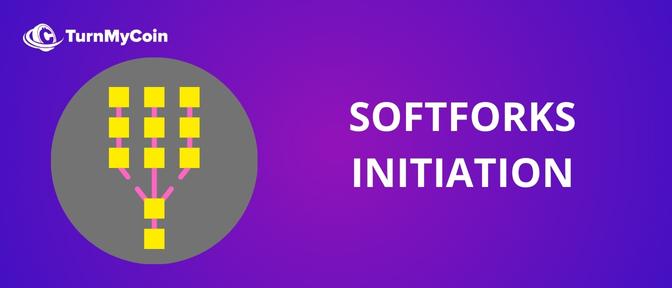
Soft forks can be initiated by network users on the Bitcoin network. By switching to a new blockchain version with a future activation point, wallet operators, exchanges, and other enterprises running full nodes can “force” miners on a network to “fall in line” and activate the new regulations. A split in the network is possible if they don’t.
In response to the secret meeting that decided Bitcoin’s fate, Bitcoin enthusiasts pushed for a user-activated soft fork to prevent a dangerous precedent from being established. They advocated for BIP 148, which would have implemented SegWit on the Bitcoin network, and they believed that SegWit2x was a divisive hard fork that left the network vulnerable to a replay attack. It came out in March 2017 with an implementation date of August 1, 2017.
Some big-block proponents planned to split the Bitcoin blockchain on August 1, 2017, out of fear that the SegWit2x plan would not be realized and in light of the community’s support for SegWit. As a result, Bitcoin Cash emerged (BCH). Instead of creating a competing network, its backers saw the fork as a natural extension of Satoshi Nakamoto’s original plan.
The original block size of Bitcoin Cash was 8 MB, but it has subsequently been extended to 32 MB. Bitcoin Cash proponents continue to argue that their cryptocurrency will outperform Bitcoin (BTC) due to the lower transaction costs it offers.
Once the Bitcoin Cash hard fork brought the prospect of a hard fork into the spotlight, many more Bitcoin forks emerged. Examples are Bitcoin Gold (BTG) and Bitcoin Diamond (BTCD).
The DAO Break-In
The establishment of the decentralized autonomous organization (DAO) on the Ethereum network in 2016 was also accompanied with a significant hard fork in the network’s history. Smart contracts are a type of program code that are executed on the Ethereum network when certain conditions are met. These contracts are the basis for applications in decentralized finance, making it possible to program money (DApps).
The DAO was one of the earliest cryptocurrency crowdfunding attempts, raising $150 million in ETH before the initial coin offering (ICO) boom of 2017. DeFi protocols use a form of decentralized governance in which token holders have a say in the protocol’s development, and this concept was an early version of this idea.
A total of 11,000 investors’ ETH, worth $60 million, was stolen shortly after the DAO became live. As 14% of all Ether in circulation was invested in the DAO when the breach occurred and Ethereum was trading below $10, it was a devastating blow to the network’s credibility.
Other points
The Ethereum community was divided over the best action in the face of the attack. Vitalik Buterin, Ethereum’s creator, suggested a soft fork to ban the attacker’s address and stop the assets from being moved.
In a response to the community, the attacker (or an imposter) claimed that the cash had been taken “legally” and in compliance with the terms of the smart contract. They said they would sue anyone who tried to steal their money. The situation escalated when the attacker threatened to bribe ETH miners with the monies in order to prevent any attempts at a soft fork.
Another round of debate happened until someone suggested drawing a strong line. The hard fork was implemented in the end, and the Ethereum network’s history was rolled back to a point before the DAO attack. This allowed investors to withdraw their assets from a smart contract once again.
Some saw this as a threat to the blockchain’s censorship resistance and immutability, while others saw it as a bailout of the investors. Those that took this view opposed the hard fork and instead stuck with the older protocol, which is now known as Ethereum Classic (ETC).
Battle of the Hashrates: ABC vs. SV
After a hard fork on the Bitcoin blockchain in August 2017, Bitcoin Cash eventually split in two as its community was torn apart by infighting. Bitcoin Cash ABC (BCHA) was one group working to enhance the underlying technology. To counter this, Bitcoin Cash SV (BSV) was formed, with assistance from Craig Wright, the self-proclaimed “Satoshi Nakamoto,” to increase the block size from 32 MB to 128 MB.
The blockchain forked in two at block 556,767, triggering a struggle over which side would use the BCH ticker sign. Both camps’ miners pooled every available resource to increase their hashrate and gain an advantage. To get the opposing network’s supporters to switch sides, several advocated for a 51% attack to restructure its blocks.
Businesses and cryptocurrency exchanges have announced that the winning blockchain will receive the BCH ticker. Several mining pools focused entirely on the hash wars, which resulted in Bitcoin Cash ABC gaining the majority of the hash rate and successfully repelling any 51% attack efforts. It adopted the